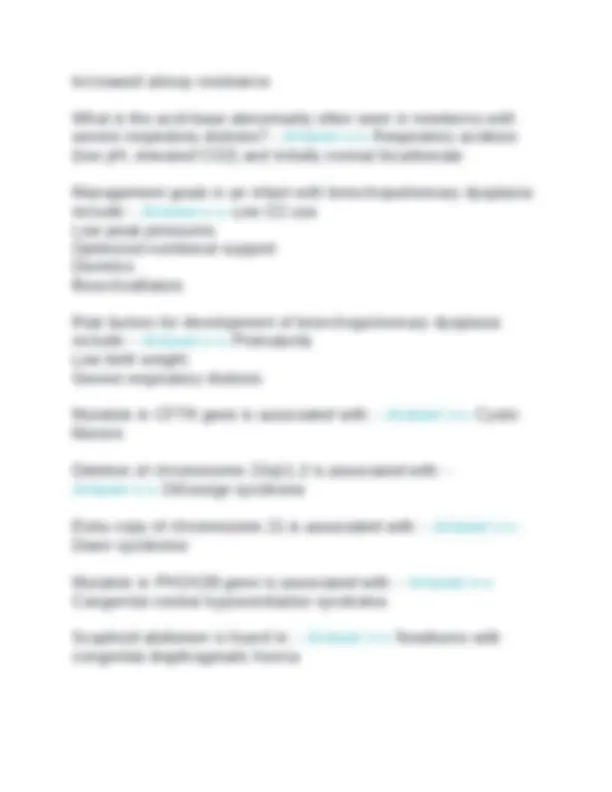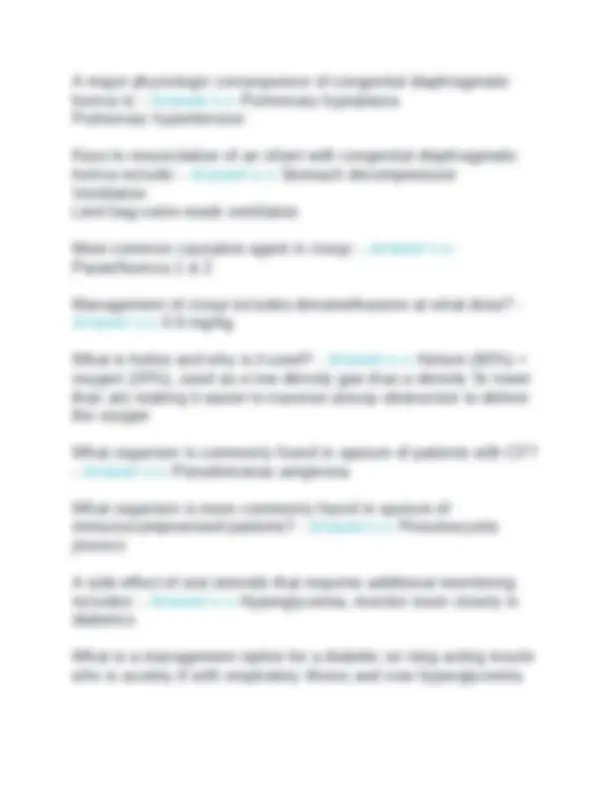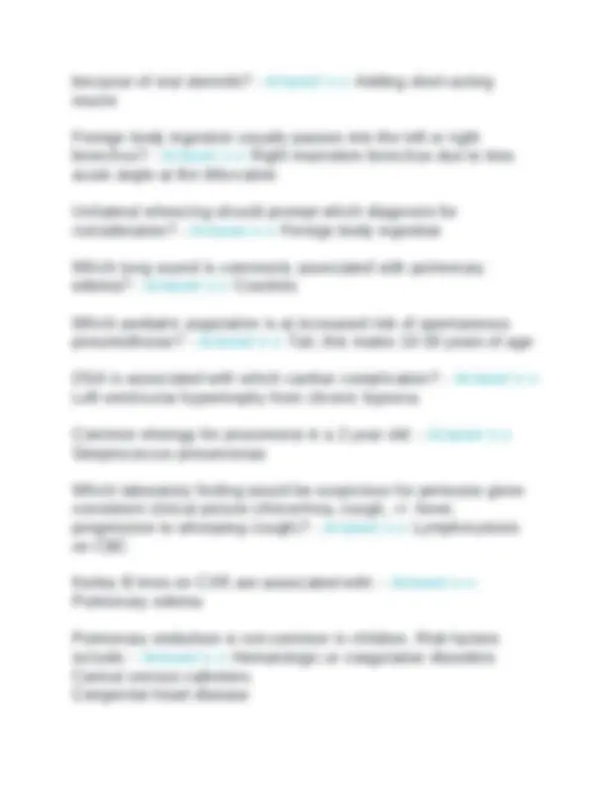





Study with the several resources on Docsity

Earn points by helping other students or get them with a premium plan


Prepare for your exams
Study with the several resources on Docsity

Earn points to download
Earn points by helping other students or get them with a premium plan
Community
Ask the community for help and clear up your study doubts
Discover the best universities in your country according to Docsity users
Free resources
Download our free guides on studying techniques, anxiety management strategies, and thesis advice from Docsity tutors
A comprehensive review of the key topics and questions related to the pulmonary pediatric nurse practitioner - acute care (pnp-ac) 2024 exam. It covers a wide range of respiratory conditions and management strategies commonly encountered in pediatric acute care settings. Detailed answers to various questions on topics such as obstructive sleep apnea, acute respiratory distress syndrome (ards), tension pneumothorax, bronchiolitis, cystic fibrosis, congenital diaphragmatic hernia, croup, and more. It also includes information on diagnostic criteria, pathophysiology, management goals, and ventilator settings. This resource could be highly valuable for pnp-ac students and practitioners preparing for the 2024 exam, as it offers a structured review of the essential knowledge and skills required for this specialty.
Typology: Exams
1 / 7

This page cannot be seen from the preview
Don't miss anything!




obstructive sleep apnea (OSA) symptoms - Answer>> Daytime sleepiness Decreased energy Decreased attention Snoring Diagnostic Evaluation for OSA - Answer>> Polysomnography +/- ECG or echo Process in Central Sleep Apnea - Answer>> Disruption of afterward or efferent signals of central respiratory center Polysonography provides what information? - Answer>> Degree of apnea or hypopnea episodes Initial management strategies for OSA - Answer>> Weight management Non-obstruction ventilation +/- tonsillectomy if hypertrophy notes Diagnostic Criteria for ARDS - Answer>> Acute onset Bilateral infiltrates on chest x-ray PaO2/FiO2 ratio < Noncardiogenic Difference between ARDS and ALI diagnostic criteria - Answer>> PaO2/ FiO2 of 200-300 for ALI; <200 for ARDS Both acute onset Both bilateral lung infiltrates on CXR Both noncardiogenic
Goal ventilator tidal volumes in management of ARDS include - Answer>> 7-8 mL/ kg A benefit of high-frequency ventilation after trial of conventional ventilation in a patient with ARDS will allow for what? - Answer>> Limiting peak inspiration pressure by providing constant distending pressure (MAP) The following is suspicious for what? Skiing accident Shortness of breath Unilateral breath sounds Hypotension - Answer>> Tension pneumothorax CXR findings in tension pneumothorax include: - Answer>> Mediastinal shift to the ipsilateral side Ipsilateral is defined as: - Answer>> Same side What happens to intrathoracic pressure change process during tension pneumothorax? - Answer>> Remains negative, equal to atmospheric pressure, drawing air into intrathoracic space URI symptoms (runny nose, congestion) followed by lower respiratory symptoms (cough, increased work of breathing) and low grade fever is consistent with which diagnosis in a 16 month old? - Answer>> Bronchiolitis Most common organism for bronchiolitis in infants? - Answer>> RSV Common pathophysiologic changes in bronchiolitis include? - Answer>> Increased mucus production
A major physiologic consequence of congenital diaphragmatic hernia is: - Answer>> Pulmonary hypoplasia Pulmonary hypertension Keys to resuscitation of an infant with congenital diaphragmatic hernia include: - Answer>> Stomach decompression Ventilation Limit bag-valve mask ventilation Most common causative agent in croup: - Answer>> Parainfluenza 1 & 2 Management of croup includes dexamethasone at what dose? - Answer>> 0.6 mg/kg What is heliox and why is it used? - Answer>> Helium (80%) + oxygen (20%), used as a low-density gas (has a density 3x lower than air) making it easier to traverse airway obstruction to deliver the oxygen What organism is commonly found in sputum of patients with CF?
because of oral steroids? - Answer>> Adding short-acting insulin Foreign body ingestion usually passes into the left or right bronchus? - Answer>> Right mainstem bronchus due to less acute angle at the bifurcation Unilateral wheezing should prompt which diagnosis for consideration? - Answer>> Foreign body ingestion Which lung sound is commonly associated with pulmonary edema? - Answer>> Crackles Which pediatric population is at increased risk of spontaneous pneumothorax? - Answer>> Tall, thin males 10-30 years of age OSA is associated with which cardiac complication? - Answer>> Left ventricular hypertrophy from chronic hypoxia Common etiology for pneumonia in a 2 year old: - Answer>> Streptococcus pneumoniae Which laboratory finding would be suspicious for pertussis given consistent clinical picture (rhinorrhea, cough, +/- fever, progression to whooping cough)? - Answer>> Lymphocytosis on CBC Kerley B lines on CXR are associated with: - Answer>> Pulmonary edema Pulmonary embolism is not common in children. Risk factors include: - Answer>> Hematologic or coagulation disorders Central venous catheters Congenital heart disease
There is risk of aspiration when using an LMA and high ventilation pressures. What is the gastroesophageal opening pressure? - Answer>> 15-25 cm H2O, try to keep ventilator pressures lower